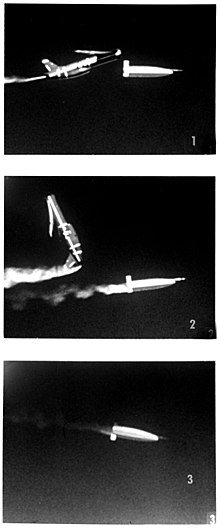SM-62 Snark
The Northrop SM-62 Snark is an early-model intercontinental range ground-launched cruise missile that could carry a W39 thermonuclear warhead.
[4]: 76 The defense budget cuts of what was called the Black Christmas of 1946 drastically reduced the number of Army missile programs.
Development of the heavy stellar navigation system intended for the N-25 Snark was very difficult and required many hundreds of hours of flight aboard aircraft.
[9] Unfortunately facilities at Cape Canaveral were still being constructed at the same time aerodynamic problems with the intended dive by the Snark on the target persisted, delaying development.
[7]: 194 The Snark, which was originally projected to become operational in 1953, suffered a protracted test program which involved significant redesigns.
[8]: 92 As the prospective operational date of the Snark slipped continuously into the future, Strategic Air Command (SAC) grew more skeptical of the missile.
[8]: 93 A high-level study by the Teapot Committee in early 1954 described the nascent Atlas ICBM project as beset by technical and administrative problems while advising that the ballistic missile offered the best means of delivering a thermonuclear weapon over intercontinental range.
[5]: 37 Also in early 1954 the Strategic Missile Evaluation Committee concluded that the Snark was an “overly complex” and would not become operational until “substantially later” than scheduled.
[8]: 93 [10]: 195 Extensive flight testing, weight reduction efforts, an improved 24 hour stellar navigation system, and the addition of pylon fuel tanks below the wings to restore range capabilities eventually resulted in the N-69E Snark which became the prototype for the SM-62 Intercontinental Missile (ICM)[8]: 95 By late 1957 N-69E Snarks had complete two flights down range to Ascension Island, showing the Snark achieved an estimated circular error probable (CEP) of 17 nautical miles (31 km; 20 mi).
[11]: 41 By 1958, the celestial navigation system used by the Snark allowed its most accurate test, which appeared to fall 4 nautical miles (7.4 km) wide of the target.
[12] However, even with the decreased CEP, the design was notoriously unreliable, with the majority of tests suffering mechanical failure thousands of miles before reaching the target.
Other factors, such as the reduction in operating altitude from 150,000 to 55,000 feet (46,000 to 17,000 m), and the inability of the Snark to detect countermeasures and perform evasive maneuvers also made it a questionable strategic deterrent.
[7]: 198 In late 1957 SAC’s 556 Strategic Missile Squadron launched its first N-69E to begin the Snark Employment and Suitability Test program.
Due to the sudden shift in its center of gravity caused by separation, the fuselage would have performed an abrupt pitch-up maneuver in order to avoid a collision with the warhead.
In March 1961, President John F. Kennedy declared the Snark to be "obsolete and of marginal military value", and on 25 June 1961, the 702nd Wing was inactivated.
A missile launched from Cape Canaveral in 1956 that was supposed to fly to Puerto Rico and back, flew so far off course that it was last seen on radar off the coast of Venezuela.



